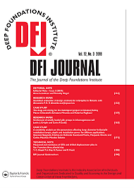
DFI Journal - The Journal of the Deep Foundations Institute
Volume 14, Issue 2, November 2020
DOI: 10.37308/DFIJnl.20190617.206
All Journal papers are free to DFI members.
If you are a member, please click on the "Login" link at the top of this page to to download this paper.
Not a member? Join here to get access to all papers or click the purchase button below to access this paper only.
How Soils Can Help Predict High Rebound of Prestressed Concrete Displacement Piles
Article Type: Research Paper
Cosentino, P. J. & Horhota, D. J.
Abstract
Excessive pile rebound has been occurring for over a decade, when high displacement prestressed concrete piles are driven mostly with single acting diesel hammers in Florida’s low permeability very fine sand blends. This very complex engineering phenomenon, which occurs due to interactions between the soil, pile, and hammer; typically is observed at depths great than approximately 15 m (50 feet). Rebound greatly diminishes the end bearing capacities, causing various problems and significant cost increases. Findings from several research studies have produced some obvious trends based on grain size, Atterberg limits and cyclic triaxial testing. Excessive rebound was categorized as movements exceeding 12.5 mm (0.5-inches) while no-rebound was considered to be less than 6 mm (0.25-inches). Coarse grained rebound soils were very fine sands, passing the number 100 sieve, with silts and clays. According to the Unified Soils Classification System they classified as SM and have silt contents between about 20 and 40%. Cohesive rebound soils were highly plastic clays, classified as CH and also have silt contents between about 20 and 40%. Cyclic triaxial testing indicated that rebound soils are much more resilient than no-rebound soils, requiring many more cycles to produce strains of 2.5, 5, 10 and 15 percent.
Keywords:
pre-stressed concrete piles, high displacement, low permeability sand, rebound soils